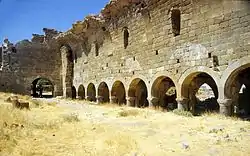Madenşehri
Madenşehri (literally “city of mines”) is a village in the central district (Karaman) of Karaman Province, Turkey. It is situated on the northern slopes of Karadağ, an extinct volcano, and is 42 kilometres (26 mi) north of the town of Karaman. The population of the village was 289[1] as of 2010.
Madenşehri | |
|---|---|
Village | |
 Ruins in Madenşehri | |
 Madenşehri Location in Turkey | |
| Coordinates: 37°26′N 33°10′E | |
| Country | |
| Province | Karaman Province |
| District | Karaman central district |
| Elevation | 1,230 m (4,035 ft) |
| Population (2010) | |
| • Total | 289 |
| Time zone | UTC+2 (EET) |
| • Summer (DST) | UTC+3 (EEST) |
| Postal code | 70000 |
| Area code(s) | 0338 |
| Licence plate | 70 |
History
Like some other Karadağ locations, Madenşehri has many early-Christian ruins. It occupies the site of the ancient city of Barata in the Roman province of Lycaonia. It became the seat of a bishopric, a suffragan of Iconium, the capital of the province. The names of five of its early bishops are known. Stephanus participated in the First Council of Nicaea in 325. Eugenius was bishop in 451, and the metropolitan bishop of Iconium Onesiphorus signed the acts of the Council of Chalcedon on his behalf. Martyrius was at a synod in Constantinople in 536. Constantinus attended the Third Council of Constantinople in 680 and signed the acts also on behalf of his metropolitan Paulus. He also attended the Trullan Council of 692. Georgius was at the Photian Council of Constantinople (879).[2][3] No longer a residential bishopric, Barata is today listed by the Catholic Church as a titular see.[4]
Place of interest
- Binbirkilise, church ruins from the Byzantine period.
References
- Statistical Institute Archived 2012-04-25 at the Wayback Machine
- Michel Lequien, Oriens christianus in quatuor Patriarchatus digestus, Paris 1740, Vol. I, coll. 1079-1080
- Raymond Janin, v. Barata, in Dictionnaire d'Histoire et de Géographie ecclésiastiques, vol. VI, 1932, col. 570
- Annuario Pontificio 2013 (Libreria Editrice Vaticana 2013 ISBN 978-88-209-9070-1), p. 846